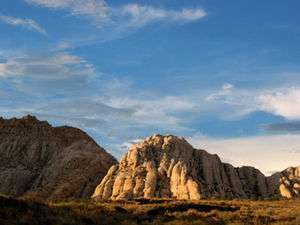Snow Canyon State Park
Snow Canyon is a state park in the Dixie region of Utah. It has strikingly beautiful scenery and offers excellent opportunities for hiking, biking, and horseback riding.
Understand

History
Snow Canyon had been inhabited by Ancestral Puebloans for hundreds of years prior to the mid-1800s. It was "discovered" again by Mormon pioneers in the 1850s. Like a lot of famous landmarks in the west, Snow Canyon was discovered by ranchers searching for lost cattle. The state park was created in 1959 and named after Lorenzo and Erastus Snow, who were prominent Utah political and religious leaders from the region.
Landscape
Snow Canyon was formed hundreds of millions ago when quartzite sand blew in, creating gigantic sand dunes. Eventually these sand dunes were covered with sediments and cemented into the red and white Navajo Sandstone that makes up much of the park. Water cut through the rock, creating canyons.
Volcanoes were quite common in the area as recently as 10,000 years ago. Lava flowed through the canyons, filling them with basalt and creating new canyons in the park. Look for the extinct volcano cones near the northern end of the park.
The park is at the intersection of the Mojave Desert (which continues to the southwest into California), the Great Basin Desert (which continues to the north and west into Nevada), and the Colorado Plateau (which continues to the east, stretching to New Mexico and Colorado).
Flora and fauna
Snow Canyon is in the high desert, so the flora are desert-hardy species, like scrub, sagebrush, and yucca. In the spring and fall, you may find a lot of desert flowers in the park. Some of the wildlife residing in the park include coyotes, roadrunners, lizards, and sidewinders.
Climate
Your typical high desert climate. Summer can get very hot during the day (highs above 100°F are common in July and August). Winters are mild, but it gets pretty chilly during the nights.
Get in
Snow Canyon is located eight miles north of St. George. Take Utah State Road 18 north and turn left on Snow Canyon Parkway, then turn right on Utah State Road 8 and enter Snow Canyon. You can also access Snow Canyon from the north via Utah State Road 18.
Fees and permits
Day passes are $10 per vehicle (up to 8 people). Camping sites are $20 with water/electric hookups, $16 without hookups.
Get around
Driving along the single road at the bottom of the canyon is the easiest way to access the trailheads and many of the sights of Snow Canyon. However, you can also hike, bike, or rollerblade on the Whiptail Trail, a 6-mile long paved trail running alongside the road. It is the only bike trail in Snow Canyon, but a fantastic one.
See
- Sand Dunes. A little attraction down the road from the campground, these little red sand dunes are a great play area for children.
- Extinct Volcano. A cinder cone on the northern end of the park, about a mile north on State Road 18. A short but steep trail leads to the top of the volcano.
- Pioneer Names. A half-mile trail where pioneers wrote their names back in the 1880s.
- Jenny's Canyon. A short, fun trail that leads into a narrow slot canyon. This trail is closed for a couple of months in Spring due to melting snow runoff.
Do
Buy
Eat
There are no restaurants around Snow Canyon. You'll have to eat in St. George.
Drink
Sleep
Lodging
Lodging is available in St. George.
Camping
You may camp in the designated area next to the Park Office. There are about 30 sites, and about half of them have water and electric hookups. Fees are $18 for a full-hookup site, $15 for a site without hookups.
You can camp only in the designated campground. No backcountry camping.
Stay safe
Go next
- Zion National Park, the most popular national park in Utah, and one of the most beautiful in the country.